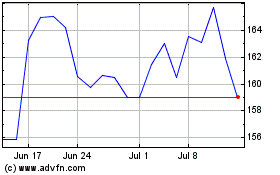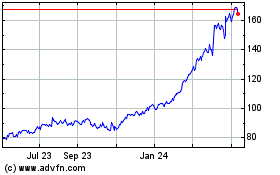By Thomas Gryta
General Electric Co. reported strong cash flow from its
industrial operations in the fourth quarter and gave an upbeat
outlook for 2020, as the conglomerate reverses losses in its power
business and its jet-engine division continues to support the rest
of the company.
GE said it generated $3.9 billion in industrial free cash flow
in the December-ended quarter, helping the company exceed its
targets for the full year. Cash flow is essentially the money
remaining after paying bills and making investments.
On Wednesday, executives projected cash flow and profits would
rise in 2020, as restructuring efforts and improved business
conditions offset challenges from the grounding of Boeing Co.'s 737
MAX jet. GE is part of a joint venture that makes the engines for
the airplane; its financial projections assume the plane returns to
service in mid-2020,.
"I'm pleased with the strong finish," CEO Larry Culp said in an
interview Wednesday. "The priorities coming into 2020 are clear,
but we are mindful that there is still a lot to do here."
GE shares jumped 9% in early Wednesday trading to $12.85, near
new 52-week highs. After tumbling below $8 last summer, the shares
have rallied as Mr. Culp makes progress on his plans to pay down
the company's debt load and streamline its operations. Strapped for
cash, GE slashed its dividend and has been selling off business
units.
The company said it will provide a detailed 2020 financial
outlook in early March.
For the full year, GE said it generated $2.3 billion in cash
flow from industrial operations, topping its goal of cash flow
between break-even and $2 billion. Early last year, Mr. Culp was
projecting the company might burn through as much as $2 billion
from the core operations in 2019, but he raised the forecasts
several times as the company made progress.
As before Mr. Culp's arrival, GE continues to rely on big
fourth-quarter results to meet its annual targets. In the first
nine months of 2019, GE produced negative cash flow of $1.6
billion.
GE has set a higher bar to clear for 2020, projecting cash flow
of $2 billion to $4 billion, despite the grounding of the MAX jet,
the loss of cash generated by its biotechnology operations and the
sale of its former oil and gas business.
After years of falling profits, investors and GE management are
focused on cash flow as the most important financial measure.
The grounding of the 737 MAX jets cut cash flow by $1.4 billion
in 2019, as expected. The aviation division, which reported that
orders rose 22% in the quarter, is GE's largest business by revenue
and its health is vital to the conglomerate's overall
turnaround.
Despite the MAX issues hitting cash flow, the aviation business
was crucial to offsetting struggles at other divisions by providing
$4.4 billion in cash flow for the year. Of GE's entire order
backlog of $405 billion, the aviation division accounts for $273
billion.
Mr. Culp said that the coming year for the division would be
complicated by the MAX's issues, including a drop in engine
shipments by half for 2020. GE will reduce its engine production
levels for the MAX but won't go to zero in order to make it easier
for the planes return to service and resume full production.
During most of 2019, Boeing was still producing planes and GE
was delivering engines. That caused a delay in GE getting paid
because the planes were not going to the final customers. Now with
Boeing's production paused, there is more uncertainty.
"We go from a relatively straight-forward delay in 2019 to a
more fluid and complex operating environment in 2020," Mr. Culp
said Wednesday.
Mr. Culp said the MAX situation is the "biggest swing factor" in
his 2020 free-cash flow projection. He expects fewer new orders,
something that reduces cash flow, but the resumption of deliveries
later in the year will help reverse that cash reduction.
In the fourth quarter, GE's net income fell 6% to $538 million
as the company continues to restructure its operations. Revenue
dropped 1% to $26.24 billion, exceeding analyst expectations of
$25.69, according to Factset Research. Excluding various items, GE
said it earned 21 cents a share, above the consensus view of 18
cents.
Orders for new equipment and services fell 3% in the quarter,
excluding acquisitions and currency swings. The decline was driven
by a 30% drop in the power division, which makes turbines for power
plants.
The division, which had been GE's biggest in terms of revenue,
has been at the center of GE's financial and operational woes. Mr.
Culp has said dramatic changes were needed in the business, which
GE has since separated into two units.
The century-old business has suffered from deep losses amid a
global drop in demand for power-generating equipment. The unit has
cut thousands of jobs to adjust to the market, but GE has said it
will take years to get the division back on track.
Mr. Culp said the business is more disciplined in dealmaking
than in previous years and signed no deals in the fourth quarter to
build entire power plants, a business GE entered with the
acquisition of Alstom in 2015.
"What we are trying to do is be more disciplined and more
thoughtful about when and where we sign up to do more than deliver
just a gas turbine," he said. He said such deals can be difficult
to meet performance and schedule requirements, making it harder to
produce the predictable margins and cash needed to make them
worthwhile.
GE is awaiting its $21 billion sale of its biopharma business to
Mr. Culp's former company Danaher Corp. The deal received
conditional clearance in Europe last month. GE plans to use the
proceeds to pay down debt. GE's 2020 projections include the
expected close of the BioPharma sale by the end of March.
For 2020, GE expects industrial revenue growth in the
low-single-digit percentage range and adjusted earnings of 50 cents
to 60 cents a share. On that basis, it had an adjusted profit of 65
cents in 2019.
Write to Thomas Gryta at thomas.gryta@wsj.com
(END) Dow Jones Newswires
January 29, 2020 11:40 ET (16:40 GMT)
Copyright (c) 2020 Dow Jones & Company, Inc.
GE Aerospace (NYSE:GE)
Historical Stock Chart
From Mar 2024 to Apr 2024

GE Aerospace (NYSE:GE)
Historical Stock Chart
From Apr 2023 to Apr 2024
